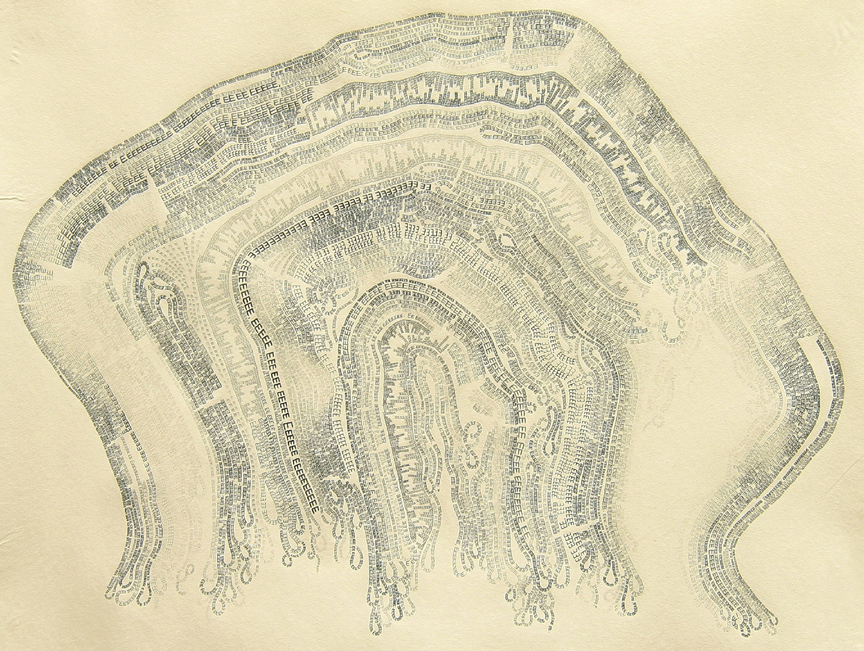Conduit Gallery is coming on strong. It’s had a particularly
solid run of shows lately. Their
room usually housing work by a different artist. Last month’s Noah Simblist-curated
effort, Collecting & Collectivity, was in my memory the only exception,
filling the whole joint with ambitious and edgy videos, installations,
paintings, and interactive sculptures. Fully enacting the darker side of
collaboration, co-curator Charissa Terranova apparently got mad at one of the artists
and severed her own connectivity. In any case, it was a good looking show, and
purely a non-profit labor of love for the gallery, as nothing was for sale. I
especially enjoyed the collaborative explorations of Otabenga Jones & Associates, Danica Phelps, and Team SHaG.
This month’s offering opened Saturday, with Justin Quinn in
the front room, Vincent Falsetta in the back, and French photographer Cedric
Delsaux in the project space. Assistant director Danette Dufhilo’s baby, the
project room is often a highlight among the plethora of offerings across the
ever-expanding Design District (I just heard about yet another gallery opening.
Must be pushing two dozen now…) Delsaux is a successful commercial photog, and
produces more personal art series as a sideline. This one
features Star Wars action figures digitally interjected into pedestrian modern
urban scenes. While clever and hilarious, they’re not really my bag – a little
too otaku trendy for me – but I respect their utter currency, and was
unsurprised to see every male under 30 losing their shizzle over them at the
reception. They’re beautifully crafted, and I’m shocked I didn’t see them at
one of the photo fairs in
this past December. Has he considered light-boxing them, I wonder?

Justin Quinn came to my attention with just such a project
room show two years ago, and I’ve enjoyed his work seeing it on occasion since.
The scale, range, and ambition of his text-ual meditations on Moby Dick have
continued to evolve, and this body of work is absolutely stellar. I don’t
understand each one exactly, but in a visual equivalent to Oulipo’s artificially
constrained verbal gymnastics, Quinn counts all the e’s in a passage,
page, or chapter of the mother text, and carefully draws each one, in different
sizes, media, and values, arranging them in purely abstract compositions.
Sinuous and spacious, they are totally contemporary, yet oddly reminiscent of
19th century city maps, with corresponding docks, curvilinear
streets, and undulating topography, or anthropological diagrams of ancient
villages. They even retain some mysterious essence of the shapes of whales and
waves and sea-life, and an imprint of Melville’s mind. Weird and cool. I could
really live with these things. The only clunker – a single page of Twombly
cursive e scribbles. While I’m sure those must have been a relief to let
fly, they just didn’t fit.
 Vincent Falsetta is a 30-year veteran painting prof at UNT,
Vincent Falsetta is a 30-year veteran painting prof at UNT,
helping make it the only art program in
I’d ever heard of before moving here three years ago. I think these paintings
rock. Not exactly Greenberg, that, but I find myself struggling to ‘come to
terms’ with why these paintings fascinate me so. For one, they precisely resist
verbal analysis. I was writing here recently about an artist who I thought
didn’t have the first clue what painting is really about. This guy, on
the other hand, is obviously a journeyman painter’s painter, with decades in
the trenches, and he’s in deep discourse with his forbears. The great thing
is, when that happens, if one is diligent, gifted, and maybe a tad lucky, you
produce something that also happens to matter.

I keep thinking about a statement by Jonathan Lasker.
Wrapping up an essay where he asserts that art’s primary function is the
retrieval of meaning from the chaos of senseless media overload, he says simply
“I consider painting a moral victory.” It just keeps going around and around in
my head, that line; it seems applicable here. I was talking to Falsetta
briefly, before we were interrupted by some woman who came up and started
blathering on at length about how she “just can’t figure out how you make these things!” I saw his smile freeze, and his eyes glass over. I knew how he
felt. I don’t know, and couldn’t care less how he gets these completely even
masses of paint squiggles to do such subtle and calculated maneuvers. What I do
know is that something in my body/mind snapped to attention when experiencing
the solid, taut, all-over surfaces of his canvases. There are no holes, no weak
areas, no points of collapse or counterpoint. There is instead a steady
electric flow, like a visual electro-magnetic field, that gently but
insistently pulls the eye every direction at once.

Most people need a hook of some kind. "How’s it made?
Why’s it matter? Ooh, look, art knitted out of dust bunnies! Wow!" Time
was when critics gave one for this kind of art’s precedents, saying that pure
abstraction was the geo-political moral high ground. Thank god we’ve graduated
from that. But in market-mad, deconstructed post-Warholian (post-?) capitalism,
artists and dealers are left to just push some trendy shtick or another,
hinging so often flimsy product on whatever sales-pitch they can concoct, or
from the idea of it being a novel expression of ‘authenticity’, or from the
drivel intravenously inserted in a grad school theory class. Maybe this alludes
to part of Lasker’s "moral victory." To see someone take the time and
the considerable effort to simply make a picture work, and that’s all – more
and more, for me, that’s enough. It the rush for new sensations, it’s certainly
fairly rare.




1 comment
From a recent interview with Noah Simblist (weshotjr.com)”Charissa took a job with UTD’s Central Track residency program midway through which made the process a little more complicated and in the end she had very little to do with the exhibition.”
I’m happy to replace the rumored account I mention with this one. Apologies if the story I was told and relate above is incorrect.